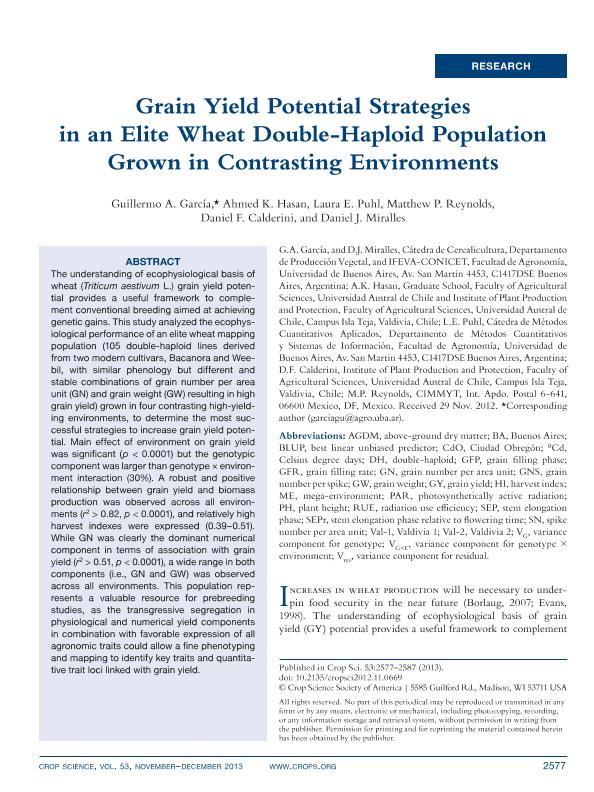Mostrar el registro sencillo del ítem
dc.contributor.author
García, Guillermo Ariel

dc.contributor.author
Hasan, Ahmed K.
dc.contributor.author
Puhl, Laura E.
dc.contributor.author
Reynolds, Matthew P.
dc.contributor.author
Calderini, Daniel F.
dc.contributor.author
Miralles, Daniel Julio

dc.date.available
2017-06-05T19:10:37Z
dc.date.issued
2013-12
dc.identifier.citation
García, Guillermo Ariel; Hasan, Ahmed K.; Puhl, Laura E.; Reynolds, Matthew P.; Calderini, Daniel F. ; et al.; Grain yield potential strategies in an elite wheat double-haploid population grown in contrasting environments; Crop Science Society Of America; Crop Science; 53; 6; 12-2013; 2577-2587
dc.identifier.issn
0011-183X
dc.identifier.uri
http://hdl.handle.net/11336/17515
dc.description.abstract
The understanding of ecophysiological basis of wheat (Triticum aestivum L.) grain yield potential provides a useful framework to complement conventional breeding aimed at achieving genetic gains. This study analyzed the ecophysiological performance of an elite wheat mapping population (105 double-haploid lines derived from two modern cultivars, Bacanora and Weebil, with similar phenology but different and stable combinations of grain number per area unit (GN) and grain weight (GW) resulting in high grain yield) grown in four contrasting high-yielding environments, to determine the most successful strategies to increase grain yield potential. Main effect of environment on grain yield was significant (p < 0.0001) but the genotypic component was larger than genotype × environment interaction (30%). A robust and positive relationship between grain yield and biomass production was observed across all environments (r2 > 0.82, p < 0.0001), and relatively high harvest indexes were expressed (0.39–0.51). While GN was clearly the dominant numerical component in terms of association with grain yield (r2 > 0.51, p < 0.0001), a wide range in both components (i.e., GN and GW) was observed across all environments. This population represents a valuable resource for prebreeding studies, as the transgressive segregation in physiological and numerical yield components in combination with favorable expression of all agronomic traits could allow a fine phenotyping and mapping to identify key traits and quantitative trait loci linked with grain yield.
dc.format
application/pdf
dc.language.iso
eng
dc.publisher
Crop Science Society Of America

dc.rights
info:eu-repo/semantics/openAccess
dc.rights.uri
https://creativecommons.org/licenses/by-nc-sa/2.5/ar/
dc.subject
Wheat
dc.subject
Crop Physiology & Metabolism
dc.subject
Plant Genetic Resources
dc.subject.classification
Agronomía, reproducción y protección de plantas

dc.subject.classification
Agricultura, Silvicultura y Pesca

dc.subject.classification
CIENCIAS AGRÍCOLAS

dc.title
Grain yield potential strategies in an elite wheat double-haploid population grown in contrasting environments
dc.type
info:eu-repo/semantics/article
dc.type
info:ar-repo/semantics/artículo
dc.type
info:eu-repo/semantics/publishedVersion
dc.date.updated
2017-06-02T17:32:09Z
dc.journal.volume
53
dc.journal.number
6
dc.journal.pagination
2577-2587
dc.journal.pais
Estados Unidos

dc.journal.ciudad
Madison
dc.description.fil
Fil: García, Guillermo Ariel. Consejo Nacional de Investigaciones Científicas y Técnicas. Oficina de Coordinación Administrativa Parque Centenario. Instituto de Investigaciones Fisiológicas y Ecológicas Vinculadas a la Agricultura. Universidad de Buenos Aires. Facultad de Agronomía. Instituto de Investigaciones Fisiológicas y Ecológicas Vinculadas a la Agricultura; Argentina
dc.description.fil
Fil: Hasan, Ahmed K.. Universidad Austral; Chile
dc.description.fil
Fil: Puhl, Laura E.. Universidad de Buenos Aires. Facultad de Agronomia; Argentina
dc.description.fil
Fil: Reynolds, Matthew P.. Centro Internacional de Mejoramiento de Maíz y Trigo; México
dc.description.fil
Fil: Calderini, Daniel F.. Universidad Austral; Chile
dc.description.fil
Fil: Miralles, Daniel Julio. Consejo Nacional de Investigaciones Científicas y Técnicas. Oficina de Coordinación Administrativa Parque Centenario. Instituto de Investigaciones Fisiológicas y Ecológicas Vinculadas a la Agricultura. Universidad de Buenos Aires. Facultad de Agronomía. Instituto de Investigaciones Fisiológicas y Ecológicas Vinculadas a la Agricultura; Argentina
dc.journal.title
Crop Science

dc.relation.alternativeid
info:eu-repo/semantics/altIdentifier/url/http://dx.doi.org/10.2135/cropsci2012.11.0669
dc.relation.alternativeid
info:eu-repo/semantics/altIdentifier/url/https://dl.sciencesocieties.org/publications/cs/abstracts/53/6/2577
Archivos asociados
